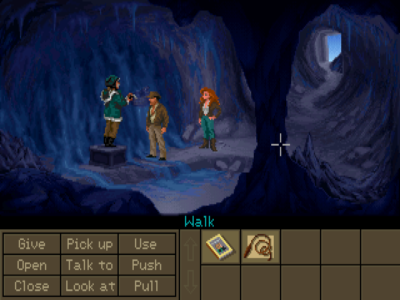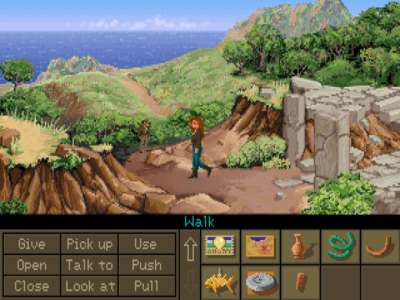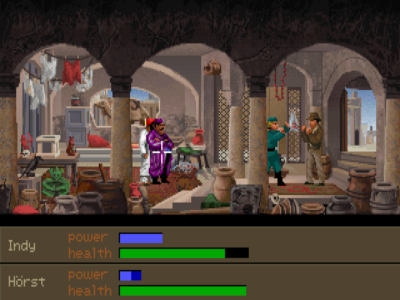
Indiana Jones and the Fate of Atlantis
Written by: Stoo
Date posted: August 16, 2008
- Genre: Adventure
- Developed by: Lucasarts
- Published by: Lucasarts
- Year released: 1993
- Our score: 9
As Rik has said, I think most people like the Indiana Jones movies. Even if you wouldn’t call yourself a major fan, they’re pretty well loved. (Well, don’t know about the latest one, and have not yet seen it myself. ) For me, Indy himself was always the best kind of hero. He’s not impossibly slick, he’s not some huge tank of a man and he’s not a martial artist. In fact he carries a sense of vulnerability through the movies, like he’s only barely surviving by the skin of his teeth. He greets some new trouble with a stressed expression or an “oh boy”, not a cold stare or a one-liner. He’s just an intrepid adventurer with quick wits, who knows when to leap across a ravine to avoid a deadly trap, and how to throw a punch when required.
Rik took on the task of reviewing Indy’s first outing on the PC – the movie-themed Last Crusade. In short it’s decent but punishing, and throws a lot of annoying fistfights at you. This then is the followup, and quite clearly the superior game. There was no prospect of a movie 4 at the time, so it heads off on new ground telling an original tale, all about that fabled lost city. Or, more to the point and true to the spirit of the movies, racing Nazis to the lost city. You’ll also be working alongside Indy’s old flame Sophia Hapgood, a former archaeologist turned “mystic”. Given how much they bicker and argue, it’s really no surprise they’re kissing by the end.
Let’s glance over the audio/visual side to start. The artwork is VGA, and I find the game still very acceptable to look at. The backdrops and landscapes in places like Iceland and the deserts of Algeria are attractive and atmospheric. The character sprites don’t have the bold cartoony look that became popular in later years but they’re still quite well animated. The score meanwhile comes via FM synthesis, giving a cheerful attempt at the classic theme and some suitably moody bits later on. It also uses Lucasart’s rather clever Imuse system to react in real-time to events.

Poking around a dig site, with Sophia in tow.
If you have the CD version (or you got this recently off Steam), you’ll be able to enjoy voice acting too. A videogame like this didn’t quite have the budget to lure Harrison Ford from his gold-plated mansion into a recording studio, but the chap standing in makes a good effort. Some of the minor characters are pretty bad, especially out in the parts set in Algeria, and the Germans sound like they’ve marched off the set of ‘Allo ‘Allo. Fortunately Sophia at least is competently voiced, so the dialogue between the two leads can be counted on to carry some feeling.
Much of the game comes down to finding the location of Atlantis; the first section is concerned with finding an ancient manuscript by Plato that supposedly contains several clues. Once you’ve managed that the game brings up one of its key features: splitting into three paths. The idea is that on each path you cover more or less the same locations and key objectives; however the puzzles and challenges encountered differ. The game will actually suggest which path you might prefer, which is a neat feature, based on which of the available solutions you take to some problems at the start.
One path is known as “fists”, and involves a lot of the same sort of punchups with Nazis as seen in the previous game. Now if you’ve played Last Crusade this might sound like a daunting prospect – my own attempt at that game came to a halt after I got fed up of endless fights in some castle. Also if you do lose a fight it’s “game over” forcing a reload – which marks a difference from the general “no deaths” policy Lucasarts had implemented by this point, for a more relaxed puzzle-solving experience.
Actually it turns out that any really tough enemies can always be stopped by other means – like dropping something heavy on them. What’s more though, I only realized when reading mobygames that most ordinary fights can be instantly won with the “sucker punch” option (hit zero). It’s not even a cheat, apparently it was mentioned in the original manual. So it turns out that punchups are completely avoidable at any point anyway.
This faux-fights situation might look a bit odd, but then we’ve run into the problem of fight scenes in traditional point-and-click adventure. They can feel like an annoying distraction, out of place, especially in a Lucasarts game. Then again, in the movies Indy does spend a lot of time getting into fights. So even if gameplay wise fighting is controversial, thematically it certainly fits. So maybe this is the best way to implement the idea – make it all optional and let people choose how challenged they want to be for themselves.

The ruins of Knossos. The VGA artwork still looks great. optional.
Anyway the other two paths stick to traditional puzzle-solving. One sees Indy by himself, the other heavily involves Sophia, with a little more emphasis on interacting with people as opposed to the environment. The latter is the more fun in my book, as the interactions between the two are often entertaining (Jones! You get back here!) although both are worthwhile. If I’m going to nitpick, one or two puzzles seem just a little goofy, or thematically more at home in Monkey Island. Like trying to find the right random item to give to a trader, so he’ll give you some food, to pass onto a beggar for a balloon ticket. However there’s also a good dose of encounters that feel just right for setting the scene in an Indy story, like poking around an abandoned dig site or exploring ancient catacombs.
In fact though these paths only account for about half the content of the game. They all come together again for a common final section, the location of which is, well, kind of given away in the title. To be fair it does seem more like a giant murky dungeon than a city (even a ruined one), and also there’s no-one to talk to. It does at least have a vaguely ominous and spooky feel though, though, of ancient and terrible powers locked beneath the earth. Which we really don’t want to let those Nazis get their hands on. And so the narrative is given a final momentum boost towards its climax.

I’m not a fan of the fighting sections, but they’re entirely optional.
In any case, overall there’s an authentic Indy adventure on offer. For a start there’s that feeling of globe-trotting adventures. You even get that traditional red line across a map tracing your movements. It’s quite satisfying to unlock some further clue to the location of Atlantis, leading you ever closer. To go with that we have sneering Nazis – utterly one-dimensional but then they’re never meant to have any kind of subtlety or depth, they’re comic-book villains. The game has a sense of humour too, even if does get just a little more silly in places, and a love interest. It plays well also, with the puzzling pitched at about the right level of challenge – you’ll be left scratching your head in a few places but it won’t punish you the way Last Crusade did.
I found myself making more criticisms of this game than I was expecting, but some of them are fairly minor. We try not to get too rose-tinted here – if you want endless glowing praise you can always look up the mobygames reviews. However we also don’t require perfection in the games we recommend. A positive assessment to me seems more reliable if the assessor acknowledges flaws along the way. If you know they’re not hopelessly blinkered, the positive notes are more trusthworthy. So then this remains one of the greats of the classic point and clickers in my book – a grand adventure, a reasonable mental workout and likeable heroes. Everyone has their own Lucasarts favourite and I shy away from proclaiming any one of the top few “the best”, but I would say it’s the best outside of the wacky comedy set. Certainly a great way to pass away a few rainy Saturdays,


 Posts
Posts